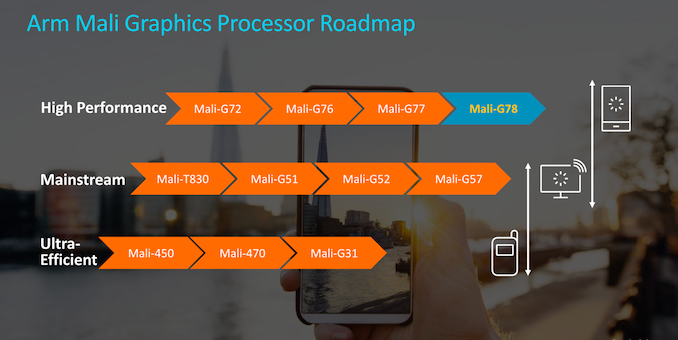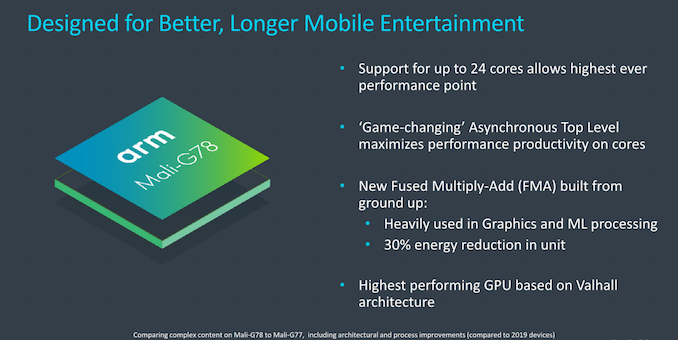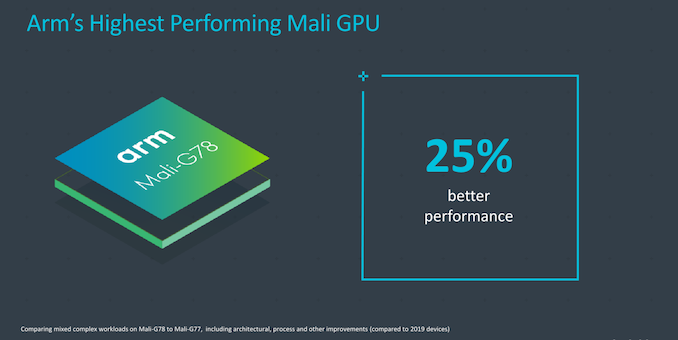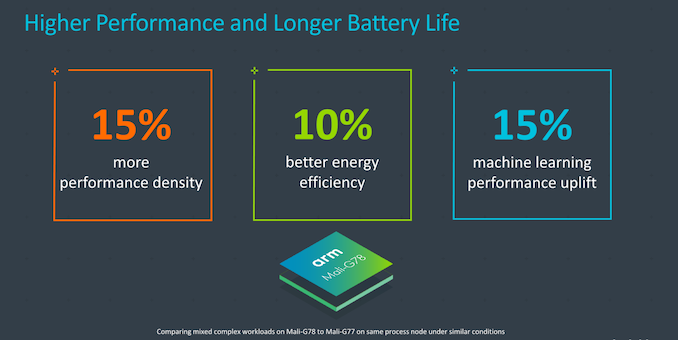Arm Announces The Mali-G78 GPU: Evolution to 24 Cores
by Andrei Frumusanu on May 26, 2020 9:00 AM EST
Today as part of Arm’s 2020 TechDay announcements, alongside the release of the brand-new Cortex-A78 and Cortex-X1 CPUs, Arm is also revealing its brand-new Mali-G78 and Mali-G68 GPU IPs.
Last year, Arm had unveiled the new Mali-G77 which was the company’s newest GPU design based on a brand-new compute architecture called Valhall. The design promised major improvements for the company’s GPU IP, shedding some of the disadvantages of past iterations and adapting the architectures to more modern workloads. It was a big change in the design, with implementations seen in chips such as the Samsung Exynos 990 or the MediaTek Dimensity 1000.
The new Mali-G78 in comparison is more of an iterative update to the microarchitecture, making some key improvements in the matter of scalability of the configuration as well as balance of the design for workloads, up to some more radical changes such as a complete redesign of its FMA units.
On the scalability side, the new Mali-G78 now goes up to 24 cores in an implementation, which is a 50% increase in core count compared to the maximum MP16 configuration of the Mali-G77. To date, the biggest configuration we’ve seen in the wild of the G77 was the M11 setup of the Exynos 990, with MediaTek employing an MP9 setup.
In a projected end-device solution comparison between 2020 and 2021 devices, Arm is projecting the new Mali-G78 to achieve 25% better performance, which includes both microarchitectural as well as process node improvements. That’s generally the reasonable target that vendors are able to achieve on newer generation IPs, but it’s also going to be strongly depending on the exact process node improvements that are projected here – as GPUs generally scale better with improves process density rather than just frequency and power improvements of the silicon.
At an ISO-process node under similar implementation area conditions, the Mali-G78 is claimed to improve performance density by 15%. This is referring to the either performing 15% better at the same area, or shaving off 15% area for the same performance, given that this can be done linearly by just adjusting the amount of GPU cores implemented.
Power efficiency sees a more meagre 10% improvement, which honestly isn’t too fantastic and not that big of a leap to the Mali-G77. ML performance is also said to be improved by 15% thanks to some new microarchitectural tweaks.
Seemingly, the Mali-G78 doesn’t look like too much of an upgrade compared to the vast new redesign we saw last year with the G77 – and in a sense, that does seem somewhat reasonable. Still, the G78 does some interesting changes to its microarchitecture, let’s dwell a bit deeper into what’s changed…














36 Comments
View All Comments
Deicidium369 - Tuesday, May 26, 2020 - link
It is a cry for help.dotjaz - Tuesday, May 26, 2020 - link
What rumor? By rumor you mean both AMD and Samsung already announced RDNA will power Exynos last year? Samsung still use exclusively Mali for at most 1 more generation. That's it. ARM can count on Samsung being a Mali customer anymore.dotjaz - Tuesday, May 26, 2020 - link
*can'tlucam - Tuesday, May 26, 2020 - link
Apple always used PowerVR, and they will again. You must have been in hibernation in the last 12months , as you don’t read news aroundSpunjji - Friday, May 29, 2020 - link
I haven't kept entirely up-to-date with this, but my understanding was that Apple went from using scaled-up versions of Imagination GPUs to using their "own design", a design which was miraculously compatible with all the low-level APIs they designed for Imagination tech. As a result of Apple's announcement, IMG's stock plummeted and they had to sell off assets and seek investment from China. Subsequently Apple went back to paying Imagination a licence fee, almost as if the whole thing was an attempt to bully a smaller company who couldn't afford extended litigation for IP theft into giving them better licencing terms.In conclusion: Apple pull this nonsense on a regular basis, and they suck.
lucam - Tuesday, May 26, 2020 - link
Apple use PowerVR, update your sourceZoolook - Tuesday, June 2, 2020 - link
Power VR is a division of Imagination, so technically you are both correct.eastcoast_pete - Tuesday, May 26, 2020 - link
My first thought was "I smell a Windows-on-ARM" laptop push here. If any of ARM's licensees (Samsung, maybe Mediatek?) wants to go down that road and join Qualcomm, they'll need a beefier graphics setup to compete with Qualcomm's 8cx designs. Maybe 24 G78s will get Samsung & Co. closer to that goal. I am actually rooting for this to happen; the low-power, always connected ultraportable space can use some new entries.eastcoast_pete - Tuesday, May 26, 2020 - link
Also, is is just me, or is ARM basically going the route used by dGPUs in the PC/Mac space (many cores/compute units)? As Andrei pointed out, that comes at the expense of some power-consuming repetition/redundancy, which is okay in a desktop or powerful laptop (big battery), but problematic if you're trying to run it all day and carry it with one hand.lucam - Tuesday, May 26, 2020 - link
New GPU, same garbage all over again..